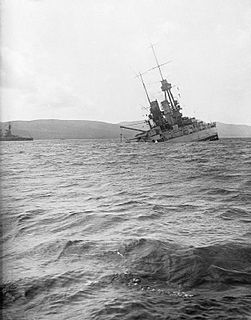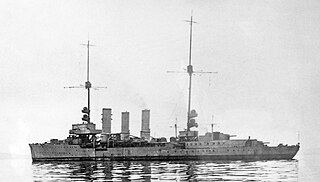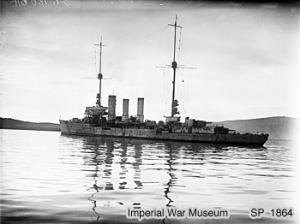 W
WThe scuttling of the German fleet took place at the Royal Navy's base at Scapa Flow, in the Orkney Islands of Scotland, shortly after the First World War. The High Seas Fleet was interned there under the terms of the Armistice whilst negotiations took place over the fate of the ships. Fearing that all of the ships would be seized and divided amongst the Allies, Admiral Ludwig von Reuter decided to scuttle the fleet.
 W
WSMS Baden was a Bayern-class dreadnought battleship of the German Imperial Navy built during World War I. Launched in October 1915 and completed in March 1917, she was the last battleship completed for use in the war; two of her sisters—Sachsen and Württemberg—were incomplete when the war ended. The ship mounted eight 38-centimeter (15 in) guns in four twin turrets, displaced 32,200 metric tons at full combat load, and had a top speed of 21 knots. Along with her sister Bayern, Baden was the largest and most powerfully armed battleship built by the Imperial Navy.
 W
WSMS Bayern was the lead ship of the Bayern class of battleships in the German Kaiserliche Marine. The vessel was launched in February 1915 and entered service in July 1916, too late to take part in the Battle of Jutland. Her main armament consisted of eight 38 cm (15 in) guns in four turrets, which was a significant improvement over the preceding König's ten 30.5 cm (12 inch) guns. The ship was to have formed the nucleus for a fourth battle squadron in the High Seas Fleet, along with three of her sister ships. Of the other ships only one—Baden—was completed; the other two were canceled later in the war when production requirements shifted to U-boat construction.
 W
WSMS Bremse was a Brummer-class minelaying light cruiser of the German Kaiserliche Marine. She was built by AG Vulcan Stettin in 1915 and launched on 11 March 1916 at Stettin, Germany, the second of the two-ship class after her sister, SMS Brummer. She served during the First World War, operating most of the time in company with her sister. The two ships took part in an ambush on a convoy in the North Sea, where they sank two destroyers in a surprise attack, before hunting down and sinking nine merchantmen, after which they returned to port unscathed.
 W
WSMS Brummer was a minelaying light cruiser of the German Kaiserliche Marine; she was the lead ship of her class. Her sister ship was Bremse. Brummer was laid down at AG Vulcan's shipyard in Stettin, Germany. in 1915 and launched on 11 December 1915 and completed on 2 April 1916. Armed with a main battery of four 15-centimeter (5.9 in) guns in single mounts, she carried 400 mines.
 W
WSMS Cöln was a light cruiser in the German Kaiserliche Marine, the second to bear this name, after her predecessor SMS Cöln had been lost in the Battle of Heligoland Bight. Cöln, first of her class, was launched on 5 October 1916 at Blohm & Voss in Hamburg and completed over a year later in January 1918. She and her sister Dresden were the last two light cruisers built by the Kaiserliche Marine; eight of her sisters were scrapped before they could be completed. The ships were an incremental improvement over the preceding Königsberg-class cruisers.
 W
WSMS Derfflinger was a battlecruiser of the German Kaiserliche Marine built in the early 1910s during the Anglo-German naval arms race. She was the lead ship of her class of three ships; her sister ships were Lützow and Hindenburg. The Derfflinger-class battlecruisers were larger and featured significant improvements over the previous German battlecruisers, carrying larger guns in a more efficient superfiring arrangement. Derfflinger was armed with a main battery of eight 30.5 cm (12 in) guns, compared to the 28 cm (11 in) guns of earlier battlecruisers. She had a top speed of 26.5 knots and carried heavy protection, including a 30-centimeter (11.8 in) thick armored belt.
 W
WSMS Dresden was the second and final ship of the Cöln class of light cruisers to be completed and commissioned in the Kaiserliche Marine. The ship was laid down in 1916 and launched on 25 April 1917; she was commissioned into the High Seas Fleet on 28 March 1918. She and her sister Cöln were the only two of her class to be completed; eight of her sisters were scrapped before they could be completed. The ships were an incremental improvement over the preceding Königsberg-class cruisers.
 W
WSMS Emden was a German light cruiser belonging to the Königsberg class, built during the First World War. Emden served in the German Imperial Navy until the end of the war, at which point she was ceded to France. The ship was named after the previous Emden, which had been destroyed at the Battle of Cocos earlier in the war. She mounted an Iron Cross on her stem-head in honor of the earlier Emden. The new cruiser was laid down in 1914 at the AG Weser shipyard in Bremen, launched in February 1916, and commissioned into the High Seas Fleet in December 1916. Armed with eight 15 cm SK L/45 guns, the ship had a top speed of 27.5 kn.
 W
WSMS Frankfurt was a light cruiser of the Wiesbaden class built by the German Kaiserliche Marine. She had one sister ship, SMS Wiesbaden; the ships were very similar to the previous Karlsruhe-class cruisers. The ship was laid down in 1913, launched in March 1915, and completed by August 1915. Armed with eight 15 cm SK L/45 guns, Frankfurt had a top speed of 27.5 knots and displaced 6,601 t at full load.
 W
WSMS Friedrich der Grosse was the second vessel of the Kaiser class of battleships of the German Imperial Navy. Friedrich der Grosse's keel was laid on 26 January 1910 at the AG Vulcan dockyard in Hamburg, her hull was launched on 10 June 1911, and she was commissioned into the fleet on 15 October 1912. The ship was equipped with ten 30.5-centimeter (12 in) guns in five twin turrets, and had a top speed of 23.4 knots. Friedrich der Grosse was assigned to III Battle Squadron of the High Seas Fleet for the majority of World War I, and served as fleet flagship from her commissioning until 1917.
 W
WSMS Grosser Kurfürst was the second battleship of the four-ship König class. Grosser Kurfürst served in the German Imperial Navy during World War I. The battleship was laid down in October 1911 and launched on 5 May 1913. She was formally commissioned into the Imperial Navy on 30 July 1914, days before the outbreak of war between Germany and the United Kingdom. Her name means Great Elector, and refers to Frederick William I, the Prince-elector of Brandenburg. Grosser Kurfürst was armed with ten 30.5-centimeter (12.0 in) guns in five twin turrets and could steam at a top speed of 21 knots.
 W
WSMS Hindenburg was a battlecruiser of the German Kaiserliche Marine, the third ship of the Derfflinger class, built to a slightly modified design. She carried the same battery of eight 30.5 cm (12 in) guns, but in improved turrets that allowed them to fire further. The ship was also slightly larger and faster than her two sister ships. She was named in honor of Field Marshal Paul von Hindenburg, the victor of the Battle of Tannenberg and the Battle of the Masurian Lakes, as well as Supreme Commander of the German armies from 1916. The ship was the last capital ship of any type built for the German navy during World War I.
 W
WSMS Kaiser was the lead ship of the Kaiser class of battleships of the Imperial German Navy. Kaiser was built by the Imperial Dockyard at Kiel, launched on 22 March 1911 and commissioned on 1 August 1912. The ship was equipped with ten 30.5-centimeter (12 in) guns in five twin turrets, and had a top speed of 23.4 knots. Kaiser was assigned to III Battle Squadron of the High Seas Fleet for the majority of World War I.
 W
WSMS Kaiserin was the third vessel of the Kaiser class of battleships of the Imperial German Navy. Kaiserin's keel was laid in November 1910 at the Howaldtswerke dockyard in Kiel. She was launched on 11 November 1911 and was commissioned into the fleet on 14 May 1913. The ship was equipped with ten 30.5-centimeter (12 in) guns in five twin turrets, and had a top speed of 22.1 knots. Kaiserin was assigned to III Battle Squadron and later IV Battle Squadron of the High Seas Fleet for the majority of her career, including World War I.
 W
WSMS Karlsruhe was a light cruiser of the Königsberg class, built for the Kaiserliche Marine during World War I. She was named after the earlier Karlsruhe, which had sunk in November 1914, from an accidental explosion. The new cruiser was laid down in 1914 at the Kaiserliche Werft shipyard in Kiel, launched in January 1916, and commissioned into the High Seas Fleet in November 1916. Armed with eight 15 cm SK L/45 guns, the ship had a top speed of 27.5 kn.
 W
WSMS König was the first of four König-class dreadnought battleships of the Imperial German Navy during World War I. König was named in honor of King William II of Württemberg. Laid down in October 1911, the ship was launched on 1 March 1913. Final construction on König was completed shortly after the outbreak of World War I; she was commissioned into the High Seas Fleet on 9 August 1914.
 W
WSMS König Albert was the fourth vessel of the Kaiser class of battleships of the Imperial German Navy. König Albert's keel was laid on 17 July 1910 at the Schichau-Werke dockyard in Danzig. She was launched on 27 April 1912 and was commissioned into the fleet on 31 July 1913. The ship was equipped with ten 30.5-centimeter (12 in) guns in five twin turrets, and had a top speed of 22.1 knots. König Albert was assigned to III Battle Squadron and later IV Battle Squadron of the High Seas Fleet for the majority of her career, including World War I.
 W
WSMS Kronprinz was the last battleship of the four-ship König class of the German Imperial Navy. The battleship was laid down in November 1911 and launched on 21 February 1914. She was formally commissioned into the Imperial Navy on 8 November 1914, just over 4 months after the start of World War I. The name Kronprinz refers to Crown Prince Wilhelm, and in June 1918, the ship was renamed Kronprinz Wilhelm in his honor. The battleship was armed with ten 30.5-centimeter (12.0 in) guns in five twin turrets and could steam at a top speed of 21 knots.
 W
WSMS Markgraf was the third battleship of the four-ship König class. She served in the Imperial German Navy during World War I. The battleship was laid down in November 1911 and launched on 4 June 1913. She was formally commissioned into the Imperial Navy on 1 October 1914, just over two months after the outbreak of war in Europe. Markgraf was armed with ten 30.5-centimeter (12.0 in) guns in five twin turrets and could steam at a top speed of 21 knots. Markgraf was named in honor of the royal family of Baden. The name Markgraf is a rank of German nobility and is equivalent to the English Margrave, or Marquess.
 W
WSMS Moltke was the lead ship of the Moltke-class battlecruisers of the German Imperial Navy, named after the 19th-century German Field Marshal Helmuth von Moltke. Commissioned on 30 September 1911, the ship was the second battlecruiser of the Imperial Navy. Moltke, along with her sister ship Goeben, was an enlarged version of the previous German battlecruiser design, Von der Tann, with increased armor protection and two more main guns in an additional turret. Compared to her British rivals—the Indefatigable class—Moltke and her sister Goeben were significantly larger and better armored.
 W
WSMS Nürnberg was a Königsberg-class light cruiser built during World War I by Germany for the Imperial Navy. She had three sisters: Königsberg, Karlsruhe, and Emden. The ship was named after the previous light cruiser Nürnberg, which had been sunk at the Battle of the Falkland Islands. The new cruiser was laid down in 1915 at the AG Weser shipyard in Bremen, launched in April 1916, and commissioned into the High Seas Fleet in February 1917. Armed with eight 15 cm SK L/45 guns, the ship had a top speed of 27.5 kn.
 W
WSMS Prinzregent Luitpold was the fifth and final vessel of the Kaiser class of battleships of the Imperial German Navy. Prinzregent Luitpold's keel was laid in October 1910 at the Germaniawerft dockyard in Kiel. She was launched on 17 February 1912 and was commissioned into the navy on 19 August 1913. The ship was equipped with ten 30.5-centimeter (12 in) guns in five twin turrets, and had a top speed of 21.7 knots.
 W
WSMS S36 was a 1913 Type Large Torpedo Boat of the Imperial German Navy during World War I, and the 12th ship of her class. She was equipped with of three single mounted 8.8 cm SK L/45 naval guns and with six 50 cm (19.7 in) torpedo tubes, two forward and four aft; twenty-four mines could also be carried. She was launched on 17 October 1914 and commissioned on 4 January 1915. S36 took part in the Battle of the Gulf of Riga in 1915 and the Battle of Jutland in 1916. In late 1916 she served in the English Channel and took part in a number of engagements, including the Battle of Dover Strait during which a British merchant ship and a destroyer were sunk by her Half-Flotilla. She was scuttled at Scapa Flow in 1919.
 W
WSMS Seydlitz was a battlecruiser of the German Kaiserliche Marine, built in Hamburg. She was ordered in 1910 and commissioned in May 1913, the fourth battlecruiser built for the High Seas Fleet. She was named after Friedrich Wilhelm von Seydlitz, a Prussian general during the reign of King Frederick the Great and the Seven Years' War. Seydlitz represented the culmination of the first generation of German battlecruisers, which had started with the Von der Tann in 1906 and continued with the pair of Moltke-class battlecruisers ordered in 1907 and 1908. Seydlitz featured several incremental improvements over the preceding designs, including a redesigned propulsion system and an improved armor layout. The ship was also significantly larger than her predecessors—at 24,988 metric tons, she was approximately 3,000 metric tons heavier than the Moltke-class ships.
 W
WSMS G102 was a German Torpedo boat that was sunk as a target by US army S.E.5 aircraft in the Atlantic Ocean off Cape Henry, Virginia, United States on 13 July 1921 after having been salvaged as war reparations following her failed scuttling in Scapa Flow two years prior.
 W
WSMS Von der Tann was the first battlecruiser built for the German Kaiserliche Marine, as well as Germany's first major turbine-powered warship. At the time of her construction, Von der Tann was the fastest dreadnought-type warship afloat, capable of reaching speeds in excess of 27 knots. She was designed in response to the British Invincible class. While the German design had slightly lighter guns—28 cm (11 in), compared to the 30.5 cm (12 in) Mark X mounted on the British ships—Von der Tann was faster and significantly better-armored. She set the precedent of German battlecruisers carrying much heavier armor than their British equivalents, albeit at the cost of smaller guns.